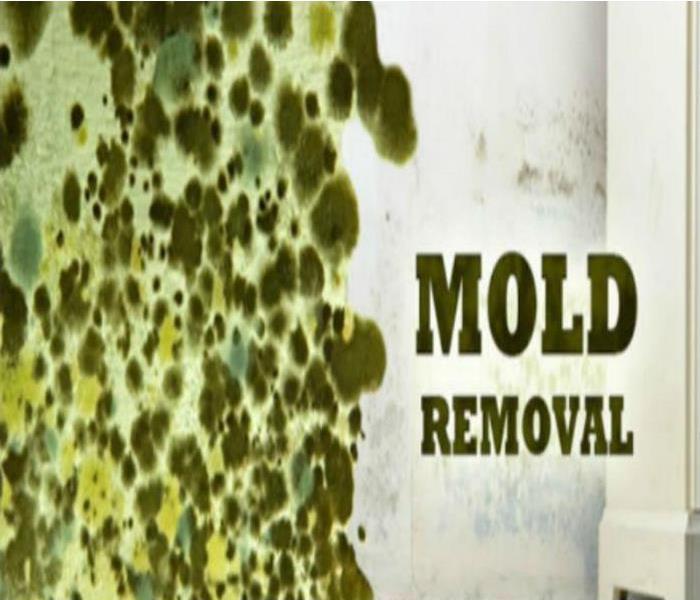Recent Mold Remediation Posts
Protecting Your Home From Mold in Needham Junction, MA
4/16/2024 (Permalink)
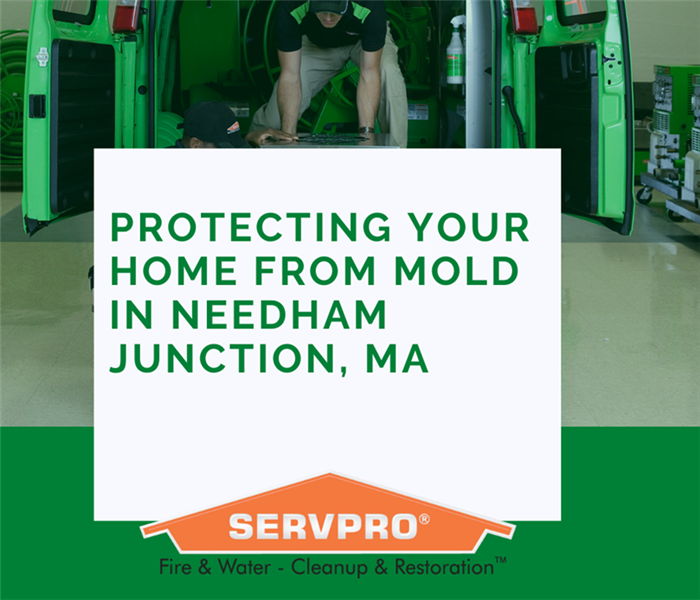 Don't let water damage disrupt your home or business operations.
Don't let water damage disrupt your home or business operations.
Water damage can rapidly wreak havoc on your home or business, leading to structural deterioration, mold growth.
When it strikes, understanding the proper assessment and restoration process is crucial for effectively mitigating destruction and restoring your property. Let's break down the key steps involved.
Step 1: Inspection
The first step is a thorough inspection of the affected areas by trained professionals. Using specialized moisture meters and thermal imaging cameras, they identify the water source, assess the extent of damage, and determine the best restoration plan - even detecting hidden moisture pockets.
Step 2: Water Extraction
With the assessment complete, it's time to remove all standing water from the premises. Industrial-grade pumps, wet/dry vacuums, and other extraction equipment rapidly eliminate water from floors, carpets, and surfaces. Prompt removal prevents further spread and secondary damage.
Step 3: Drying
Once extracted, high-speed air movers and dehumidifiers are strategically placed to dry out the area and restore normal humidity levels. This process may take several days, depending on the materials impacted and saturation levels.
Step 4: Restoration
With affected areas fully dried, restoration begins. This involves repairing or replacing damaged drywall, flooring, structures, and contents to return the property to its preloss condition - clean, safe, and inhabitable.
The Importance of Rapid Response
Swift action is paramount when water damage occurs. Prolonged moisture can rapidly lead to compounding issues like mold growth, compromised structures. By responding immediately and involving professionals, you minimize destruction and expedite the restoration process.
Don't let water damage disrupt your home or business operations. The trained experts at SERVPRO of Newton / Wellesley are prepared to swiftly respond and properly assess, extract, dry, and restore your property. With their advanced equipment and proven techniques, they'll make water damage "Like it never even happened."
Service Areas
Newton, MA | Wellesley, MA | Needham, MA | Waban, MA | Chestnut Hill, MA | Newton Upper Falls, MA | Newton Highlands, MA | Needham Junction, MA | Thompsonville, MA | Newton Lower Falls, MA
Is Mold a Winter Worry? Exploring Cold-Weather Mold Concerns In Newton Wellesley MA.
1/29/2024 (Permalink)
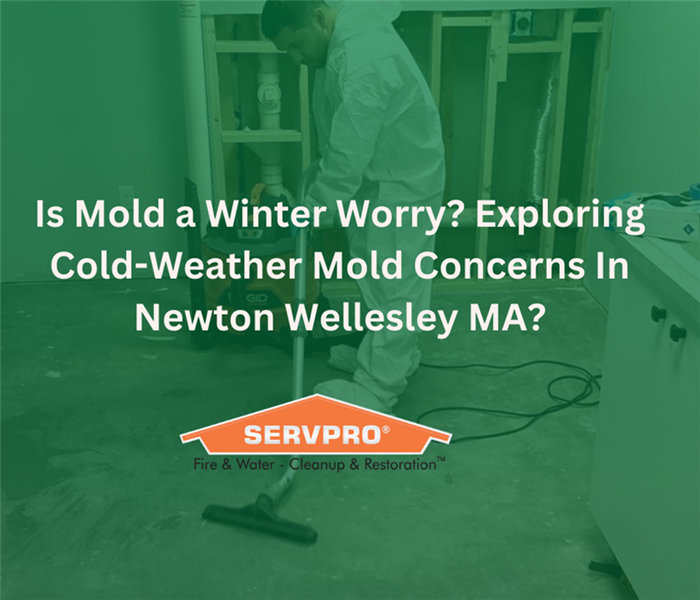 While mold concerns may not be as prominent in winter as in warmer seasons, cold weather brings its own conditions that can contribute to mold growth.
While mold concerns may not be as prominent in winter as in warmer seasons, cold weather brings its own conditions that can contribute to mold growth.
When considering mold growth, the common association is with damp and warm conditions, typically prevalent in summer.
However, mold is not exclusively a concern during the warmer months—winter presents its own set of conditions that can contribute to mold growth in unexpected places. Let's explore whether mold is a winter worry and discuss the cold-weather concerns that homeowners and businesses should be aware of in Newton Wellesley MA.
Condensation and Indoor Humidity:
- Cold-Weather Concern: During winter, temperature differentials between outdoor and indoor environments can lead to condensation on windows, walls, and surfaces. This moisture, combined with indoor humidity, creates conditions conducive to mold growth.
- Preventive Measures: Maintain indoor humidity levels below 60% and use exhaust fans in moisture-prone areas like bathrooms and kitchens. Ensure proper ventilation to reduce condensation on windows.
Ice Dams and Roof Leaks:
- Cold-Weather Concern: Ice dams, formed by melting and refreezing snow on roofs, can result in water infiltration and roof leaks. If not addressed promptly, this moisture can create conditions favorable for mold growth in attics and ceilings.
- Preventive Measures: Properly insulate and ventilate attics to prevent ice dams. Regularly inspect roofs for leaks and promptly address any issues to prevent water damage.
Mold in Heating Systems:
- Cold-Weather Concern: Mold can thrive in heating systems, particularly in ductwork and on heating coils. As warm air circulates through the system, it can spread mold spores throughout the building.
- Preventive Measures: Regularly inspect and clean HVAC systems, including ductwork and coils. Use high-quality air filters and consider professional HVAC maintenance.
Basement Moisture Issues:
- Cold-Weather Concern: Cold temperatures can lead to condensation on basement walls and floors. Additionally, melting snow and frozen ground can contribute to moisture entering basements.
- Preventive Measures: Seal any cracks in basement walls, ensure proper drainage away from the foundation, and use dehumidifiers to control indoor humidity levels.
Firewood Storage:
- Cold-Weather Concern: Storing firewood indoors for winter heating can introduce moisture into the home, creating conditions suitable for mold growth.
- Preventive Measures: Store firewood outdoors in a dry, covered area, and bring in only small amounts at a time. Keep firewood away from walls and off the ground.
While mold concerns may not be as prominent in winter as in warmer seasons, cold weather brings its own conditions that can contribute to mold growth.
Understanding these cold-weather mold concerns and implementing preventive measures, such as regular maintenance, proper ventilation, and moisture control, are crucial for creating environments less conducive to mold development.
This approach ensures a healthy and mold-free indoor environment throughout the winter months in Newton Wellesley MA.
Understanding Water and Mold Damage from Winter Pipe Breaks in Newton Wellesley.
12/5/2023 (Permalink)
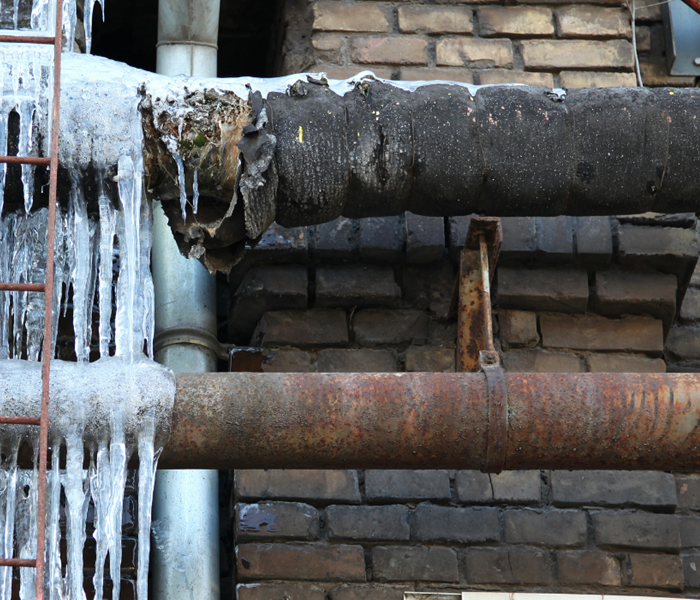 Winter pipe breaks and the ensuing water and mold damage can be a homeowner's nightmare.
Winter pipe breaks and the ensuing water and mold damage can be a homeowner's nightmare.
As winter drapes the world in a tranquil blanket of snow, it also brings the potential for a less picturesque yet prevalent issue: frozen pipes. The chilling temperatures can wreak havoc on plumbing systems, leading to pipe breaks that result in water damage and, subsequently, mold growth. Explore the causes of winter pipe breaks, the repercussions of water damage, and effective measures to prevent and address the aftermath in Newton Wellesley.
Understanding Winter Pipe Breaks:
- Freezing Temperatures: The primary cause of winter pipe breaks is freezing temperatures. When water within pipes freezes, it expands, exerting considerable pressure on the pipe walls. This heightened pressure can result in cracks, bursts, or complete ruptures in the plumbing system.
- Poor Insulation: Insufficient insulation around pipes elevates the risk of freezing. Pipes exposed in attics, basements, or crawl spaces are particularly susceptible. Adequate insulation helps maintain a steady temperature and shields pipes from the harsh winter cold.
Consequences of Winter Pipe Breaks:
- Water Damage: A burst pipe can release a substantial amount of water into your home or business, causing extensive damage to walls, floors, and belongings. Swift action is imperative to prevent further harm and reduce repair costs.
- Mold Growth: With the introduction of water, the risk of mold growth escalates. Mold thrives in damp, humid environments, and the aftermath of a pipe break provides an ideal breeding ground.
Preventing and Mitigating Water Damage:
- Insulate Pipes: Ensure proper insulation for all pipes, especially those in vulnerable areas, to maintain a consistent temperature and minimize the risk of freezing.
- Keep Interior Spaces Warm: Maintain a warm environment within your home or business, especially in areas with exposed pipes, achieved through proper heating and insulation.
- Drip Faucets: During extremely cold nights, allow faucets to drip slowly to keep water flowing, reducing the likelihood of pipes freezing.
- Seal Leaks: Regularly inspect and seal any leaks in your home's structure, as even small leaks can lead to significant problems when temperatures drop.
- Emergency Plan: Establish an emergency plan, familiarizing yourself with the location of your main water shut-off valve and the procedure to turn it off swiftly. This knowledge can help minimize damage in the event of a pipe break.
Winter pipe breaks and the ensuing water and mold damage can be a homeowner's nightmare. However, with proper precautions and a proactive maintenance approach, you can significantly diminish the risk of such incidents. Remember, prevention is paramount, but in the unfortunate event of a pipe break, swift action is crucial to mitigate the damage and shield your home from the harsh consequences of winter's icy grasp.
SERVPRO Of Newton Wellesley is The #1 Choice in Cleanup and Restoration for residential and commercial buildings’ mold damage.
Mold FAQ: Your Comprehensive Guide to Understanding Mold
10/25/2023 (Permalink)
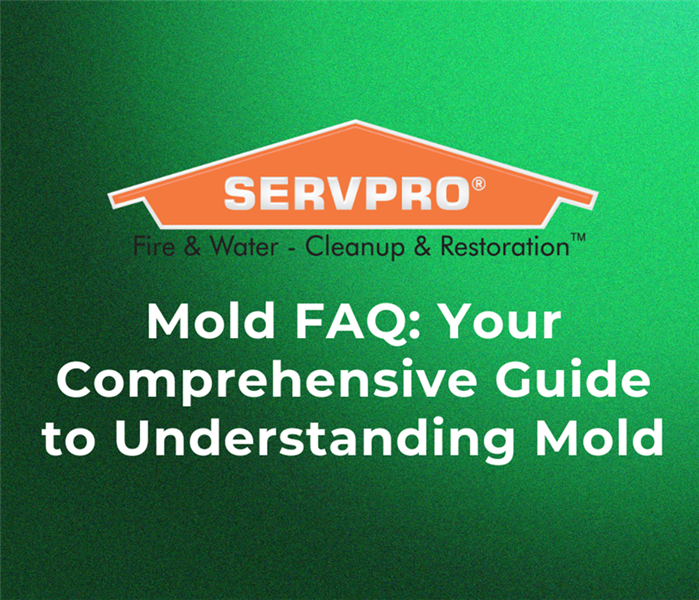 Understanding mold and how to deal with it is essential for maintaining a healthy and safe living environment.
Understanding mold and how to deal with it is essential for maintaining a healthy and safe living environment.
Mold is a common household problem that can lead to various health issues and property damage in Newton Wellesley MA.
Many people have questions about mold. Here are answers to some frequently asked questions (FAQ) about mold to help you better understand this issue and how to deal with it effectively.
What is Mold?
Mold is a type of fungus that grows in the form of multicellular filaments called hyphae. It thrives in damp, humid conditions and can appear in various colors and textures. While some molds are harmless, others can produce mycotoxins, which can be harmful to human health.
What Causes Mold Growth?
Mold requires moisture, warmth, and organic material to grow. Common causes of mold growth in homes include water leaks, high humidity, poor ventilation, and damp building materials. Areas like bathrooms, basements, and kitchens are particularly susceptible to mold infestations.
Is Mold Dangerous to Health?
Yes, mold can be harmful to health, especially if it produces mycotoxins. Exposure to mold spores and mycotoxins can lead to a range of health issues, including allergies, respiratory problems, skin irritation, and more severe conditions in individuals with compromised immune systems. It's essential to address mold problems promptly to protect your health.
How Can I Prevent Mold Growth?
To prevent mold growth, you can take several proactive steps:
- Control indoor humidity levels (ideally between 30-50%).
- Fix any leaks or water damage promptly.
- Ensure proper ventilation in high-moisture areas.
- Use exhaust fans in bathrooms and kitchens.
- Clean and dry wet or damp materials and surfaces promptly.
- How Do I Identify Mold in My Home?
Mold is often visually identifiable by its fuzzy or slimy appearance and can come in various colors like black, green, white, or brown. You may also notice a musty odor in mold-infested areas. If you suspect mold, it's a good idea to consult a professional for a thorough inspection in Needham Junction, MA.
Can I Remove Mold Myself?
For small, surface-level mold problems (less than 10 square feet), you can attempt to clean it yourself using appropriate protective gear, such as gloves, a mask, and eye protection. Use a mixture of soap and water or a specialized mold cleaner. However, for extensive mold infestations, it's best to consult a professional mold remediation service.
How Can I Prevent Mold Recurrence?
To prevent mold from returning, continue to maintain a dry, well-ventilated environment in your home. Regularly inspect for leaks and address any moisture issues promptly. Consider using dehumidifiers in damp areas and ensuring your HVAC system is clean and well-maintained.
Do Home Insurance Policies Cover Mold Damage?
Home insurance policies may cover mold damage, but the coverage can vary widely. It typically depends on the cause of the mold and the specific terms of your policy. To ensure you're adequately covered, review your policy and consult with your insurance provider if necessary.
Understanding mold and how to deal with it is essential for maintaining a healthy and safe living environment. By following preventive measures, promptly addressing moisture issues, and seeking professional help when needed, you can effectively manage and mitigate mold problems in your home in Needham Junction, MA. If you have concerns about mold in your living space, it's always wise to consult with experts who can provide guidance and remediation services to keep your home mold-free and safe for your family's well-being.
SERVPRO® Of Newton Wellesley is The #1 Choice in Cleanup and Restoration for residential and commercial buildings’ fire, mold, water, and storm damage. Call us today at (617) 332-9000
Dealing with Mold: Your Comprehensive Guide to Mold Remediation
9/6/2023 (Permalink)
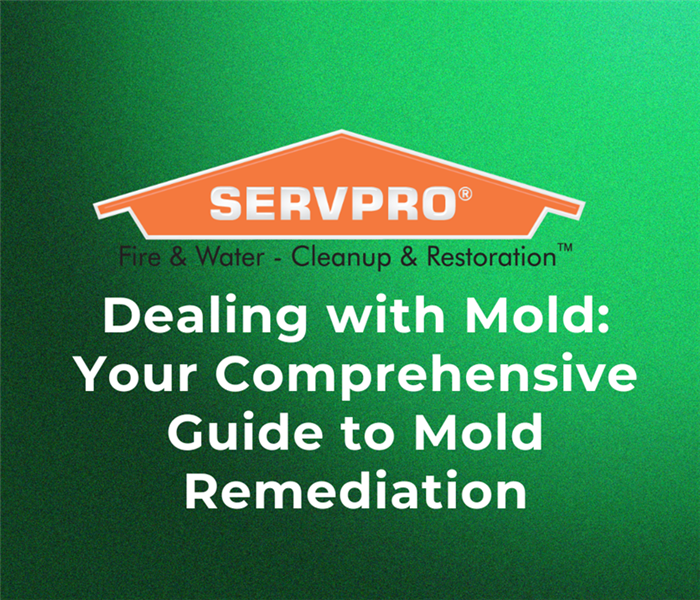 Dealing with mold can be a daunting task, but with the right knowledge and precautions, you can effectively address the issue and protect your home
Dealing with mold can be a daunting task, but with the right knowledge and precautions, you can effectively address the issue and protect your home
Mold thrives in damp, dark, and humid environments, making basements, bathrooms, and kitchens susceptible areas. Not only is mold unsightly, but it can also pose health risks if left unaddressed. Here is what to do if you discover mold in your home and how to effectively tackle this issue.
- Identify the Mold: Before you can effectively deal with mold, you need to identify the type and extent of the infestation. There are various types of mold, with some being more harmful than others. Common indoor molds include black mold (Stachybotrys chartarum), green mold (Aspergillus), and white mold (Penicillium). If you are unsure about the type of mold you are dealing with, consider hiring a professional mold inspector who can provide an accurate assessment.
- Safety First: When dealing with mold, safety should be your top priority. Mold can release harmful spores and mycotoxins into the air, which can be dangerous when inhaled. To protect yourself, follow these safety precautions:
- Wear protective gear, including an N95 respirator, gloves, and eye protection.
- Isolate the contaminated area to prevent mold spores from spreading to other parts of your home.
- Ensure proper ventilation by opening windows and doors to allow fresh air to circulate.
- Remove Moisture Sources: Mold thrives in moist environments, so the first step in mold remediation is to identify and eliminate the source of moisture. Fix any leaks, repair roof damage, and improve ventilation in damp areas like basements and bathrooms. A dehumidifier can also help reduce humidity levels in your home.
- Cleaning and Mold Removal: The method of mold removal depends on the extent of the infestation and the affected materials. Here are some general steps to follow:
- For small surface mold growth, clean the affected area with a mixture of soap and water or a commercial mold cleaner.
- For larger infestations, you may need to remove and replace contaminated materials, such as drywall, insulation, or carpet. Be cautious not to disturb the mold, as this can release more spores into the air.
- Consider Professional Help: If the mold problem is extensive, toxic mold is suspected, or you have health concerns, it's advisable to hire a professional mold remediation service. These experts have the necessary equipment and expertise to safely and effectively remove mold from your home.
After you have successfully removed the mold, take steps to prevent it from returning:
- Maintain proper ventilation and humidity levels in your home.
- Regularly inspect and repair any leaks or water damage.
- Clean and dry damp areas promptly.
- Use mold-resistant materials in areas prone to moisture.
Dealing with mold can be a daunting task, but with the right knowledge and precautions, you can effectively address the issue and protect your home and health. Remember that safety should always come first, and when in doubt, seek professional assistance. By identifying and addressing the source of the problem and following proper remediation procedures, you can create a healthier living environment for you and your family.
SERVPRO Of Newton Wellesley is The #1 Choice in Cleanup and Restoration for residential and commercial buildings’ fire, mold, water, and storm damage. If you are looking for assistance, just click on the contact us page, and someone will be in touch shortly.
Can Mold Cause A Smell To The House?
5/24/2023 (Permalink)
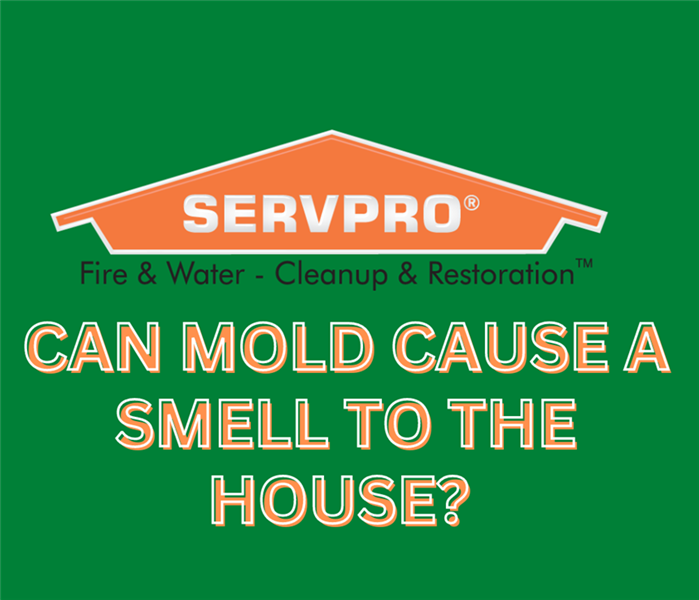 If you discover mold in your home, it's important to take action to remove it as soon as possible.
If you discover mold in your home, it's important to take action to remove it as soon as possible.
Mold is a common problem that homeowners face, especially in humid or damp areas of the house. Not only can mold cause damage to your home and pose health risks, but it can also create a foul smell that can be difficult to get rid of.
What Causes the Smell?
Mold releases a musty odor that can be quite unpleasant. This smell is caused by the chemicals released by mold as it grows and breaks down organic matter. Mold thrives in damp environments, such as bathrooms, basements, and areas with water damage. If you notice a musty odor in your home, it could be a sign that mold is present.
Health Risks Associated with Mold.
Mold not only creates a foul smell but can also pose health risks to you and your family. Exposure to mold can cause allergic reactions, respiratory problems, and other health issues. Children, the elderly, and people with weakened immune systems are particularly vulnerable to mold-related health problems. If you suspect that mold is present in your home, it's important to take action to address the issue as soon as possible.
Here are some steps you can take to prevent mold growth in your home:
- Reduce humidity levels: Mold thrives in humid environments, so it's important to keep humidity levels low. Use dehumidifiers in areas prone to moisture, such as basements and bathrooms.
- Fix leaks: Mold needs moisture to grow, so fixing any leaks in your home is crucial. Check for leaks around windows, doors, and pipes, and repair them promptly.
- Use ventilation: Proper ventilation can help prevent mold growth. Use exhaust fans in bathrooms and kitchens, and open windows to increase airflow.
- Clean regularly: Regular cleaning can help prevent mold growth. Clean surfaces regularly with a solution of bleach and water, and use mold-resistant paint in areas prone to moisture.
If you discover mold in your home, it's important to take action to remove it as soon as possible. Here are some steps you can take to remove mold:
- Identify the source: Identify the source of the moisture that's causing the mold to grow. Fix any leaks or water damage before removing the mold.
- Use protective equipment: Wear protective equipment, such as gloves and a mask, to avoid inhaling mold spores.
- Clean surfaces: Clean surfaces with a solution of bleach and water. Use a scrub brush to remove the mold from porous surfaces, such as drywall.
- Dry the area: After cleaning the mold, dry the area thoroughly to prevent the mold from returning.
Prevention is key when it comes to dealing with mold. Reduce humidity levels, fix leaks, use ventilation, and clean regularly to prevent mold growth. If you discover mold in your home, take action to remove it promptly.
SERVPRO Of Newton Wellesley is The #1 Choice in Cleanup and Restoration for residential and commercial buildings’ fire, mold, water, and storm damage.
We service Dedham, East Dedham, Endicott, Medfield, Norwood Centre, Norwood, Walpole, MA, and Westwood, MA
What to do if there is mold in your walls
4/7/2023 (Permalink)
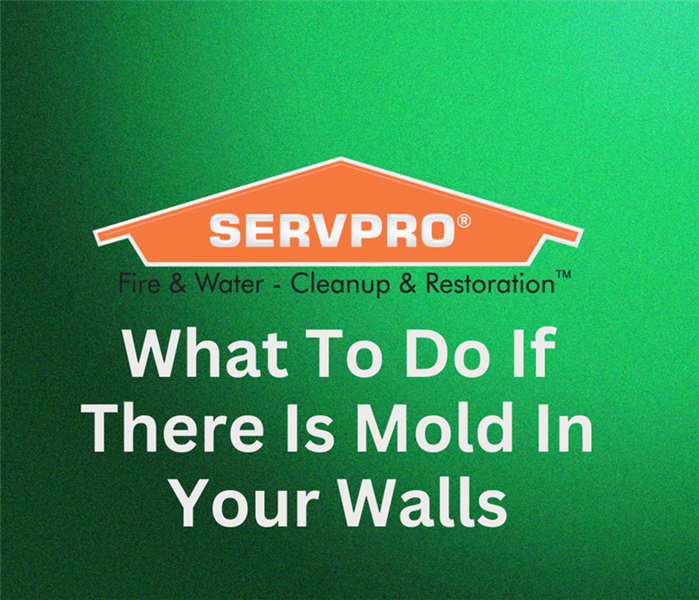 If you have mold on your walls, it's important to take action as soon as possible to prevent it from spreading
If you have mold on your walls, it's important to take action as soon as possible to prevent it from spreading
If you have mold on your walls, it's important to take action as soon as possible to prevent it from spreading and causing further damage.
Here are some steps you can take to deal with mold on your walls:
- Identify the cause of the mold: The first step in dealing with mold on your walls is to identify the underlying cause. Mold thrives in damp, humid environments, so it's important to identify any sources of moisture that may be contributing to the problem. Common causes of mold on walls include leaky pipes, roof leaks, high humidity levels, and poor ventilation.
- Remove the mold: Once you have identified the cause of the mold, it's time to remove it from your walls. Depending on the severity of the mold, you may be able to clean it yourself using a mixture of water and bleach or vinegar. However, if the mold has spread over a large area or is particularly stubborn, it's best to call in a professional mold remediation company to ensure that it is completely removed.
- Repair any damage: Once the mold has been removed, it's important to repair any damage to your walls. This may include replacing any damaged drywall or insulation, repairing leaks, or installing a dehumidifier to help control moisture levels.
- Prevent future mold growth: To prevent mold from growing on your walls in the future, it's important to take steps to control moisture levels in your home. This may include repairing any leaks promptly, using a dehumidifier in areas with high humidity, and ensuring that your home is properly ventilated.
Dealing with mold on your walls can be a daunting task, but it's important to take action as soon as possible to prevent it from spreading and causing further damage.
We service Needham Junction, Needham, Newton Highlands, Newton Lower Falls, Newton Upper Falls, Thompsonville, Waban, and Wellesley, MA
SERVPRO Of Newton Wellesley is The #1 Choice in Cleanup and Restoration for residential and commercial buildings’ fire, mold, water, and storm damage.
How to prevent mold damage in Newton Wellesley MA
3/5/2023 (Permalink)
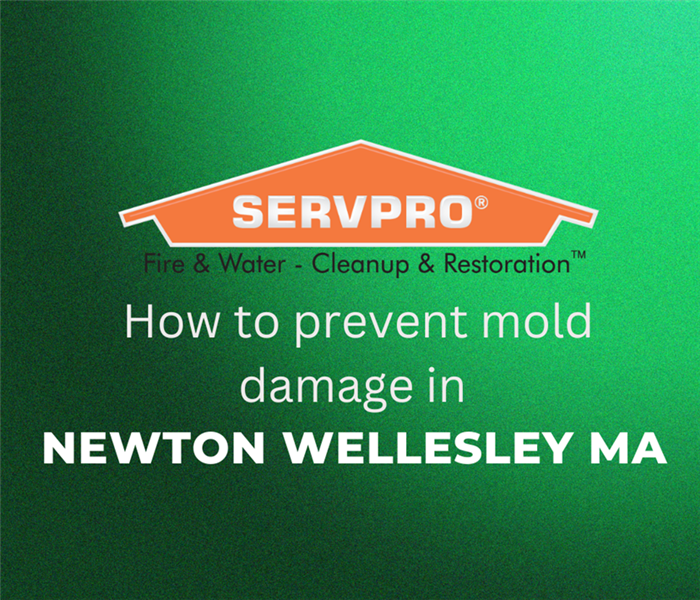 SERVPRO Of Newton Wellesley is The #1 Choice in Cleanup and Restoration for residential and commercial buildings’ fire, mold, water, and storm damage.
SERVPRO Of Newton Wellesley is The #1 Choice in Cleanup and Restoration for residential and commercial buildings’ fire, mold, water, and storm damage.
Mold is a common problem that affects many households. It can cause significant damage to your property and even pose a health risk to you and your family. Mold grows in damp and humid environments, and it can thrive on various surfaces, including walls, ceilings, carpets, and furniture. Fortunately, there are ways to prevent mold damage in your home.
- Keep your home dry: Mold thrives in damp and humid environments, so the best way to prevent mold damage is to keep your home dry. You can do this by fixing any leaks in your plumbing, roof, or windows. Make sure that your home is properly ventilated, especially in areas like the bathroom, kitchen, and laundry room. Use a dehumidifier if necessary to reduce the humidity levels in your home.
- Clean and maintain your HVAC system: Your HVAC system plays a crucial role in maintaining the air quality in your home. It can also help to prevent mold growth. Make sure to clean and maintain your HVAC system regularly to prevent any buildup of dust or moisture, which can lead to mold growth. Replace your air filters at least once every three months to ensure that your system is running efficiently.
- Use mold-resistant products: When renovating or building your home, consider using mold-resistant materials such as drywall, paints, and insulation. These materials are specially designed to resist mold growth and can help to prevent mold damage in the long run.
- Monitor indoor humidity levels: Mold thrives in humid environments, so it's important to keep an eye on indoor humidity levels. The ideal humidity level is between 30 and 50 percent. You can use a hygrometer to measure the humidity levels in your home.
- Clean and dry any water damage promptly: Water damage is one of the leading causes of mold growth. If you experience any water damage in your home, it's important to clean and dry the affected area as soon as possible.
Mold damage can be a significant problem for homeowners, but it's a problem that can be prevented.
We service Needham Junction, Needham, Newton Highlands, Newton Lower Falls, Newton Upper Falls, Thompsonville, Waban, and Wellesley, MA
SERVPRO Of Newton Wellesley is The #1 Choice in Cleanup and Restoration for residential and commercial buildings’ fire, mold, water, and storm damage.
How Does Mold Damage Happen?
2/15/2023 (Permalink)
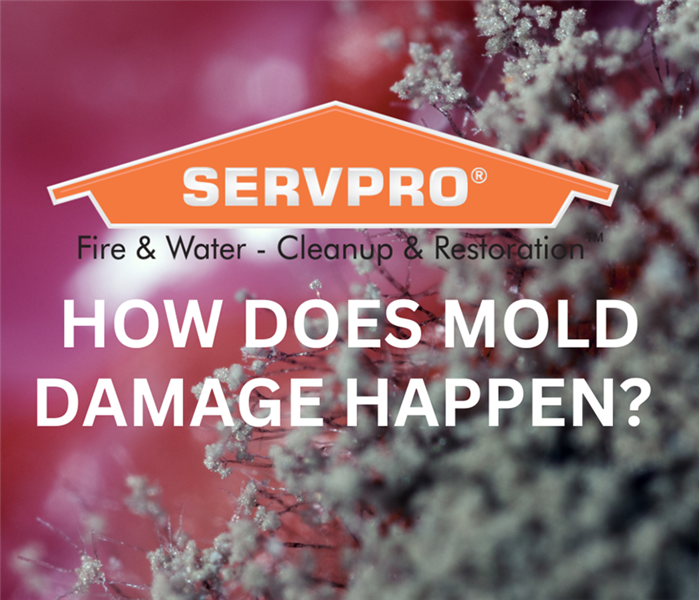 Mold damage is a serious problem that can have a number of negative effects on a building and its occupants.
Mold damage is a serious problem that can have a number of negative effects on a building and its occupants.
Mold is a type of fungus that thrives in damp and humid environments. It grows quickly and can spread rapidly, causing damage to the structure of a building and posing a health risk to its occupants. Mold damage is a serious problem that requires immediate attention and remediation. In this blog post, we will explore the causes and effects of mold damage, as well as how to prevent and address it.
Causes of Mold Damage
Mold thrives in damp and humid conditions. This means that any area of a building that is exposed to moisture is at risk of developing mold. Some of the most common causes of mold damage include:
- Water leaks: Leaky pipes, roofs, and windows can all contribute to the growth of mold.
- Flooding: If a building is flooded, the excess water can create a perfect breeding ground for mold.
- Humidity: High levels of humidity in a building can create conditions that are ideal for mold growth.
- Poor ventilation: Without adequate ventilation, moisture can become trapped in a building, providing a perfect environment for mold to grow.
Effects of Mold Damage
Mold damage can have a number of negative effects on a building and its occupants. Some of the most common effects include:
- Structural damage: Mold can weaken the structure of a building, leading to cracks, warping, and other forms of damage.
- Health risks: Exposure to mold can lead to a number of health problems, including respiratory issues, allergic reactions, and skin irritation.
- Property damage: Mold can damage walls, floors, and other surfaces, requiring expensive repairs and replacements.
Prevention of Mold Damage
Preventing mold damage is much easier than dealing with it after it has already occurred. Here are some tips for preventing mold growth in your building:
- Keep humidity levels under control: Make sure that your building has adequate ventilation and use dehumidifiers to control humidity levels.
- Repair water leaks: Fix any leaks as soon as they are detected to prevent moisture from building up.
- Keep your building clean: Regular cleaning can help prevent mold growth by removing any spores that may be present.
- Inspect your building regularly: Regular inspections can help you identify any potential problems before they become major issues.
Remediation of Mold Damage
If you suspect that you have mold damage in your building, it is important to address the problem as soon as possible. Here are the steps involved in mold remediation:
- Identify the source of the problem: Determine the source of the moisture that is causing the mold growth.
- Contain the mold: Use barriers to prevent the mold from spreading to other areas of the building.
- Remove the mold: Use specialized equipment and cleaning agents to remove the mold.
- Repair any damage: Repair any damage that was caused by the mold growth.
- Take steps to prevent future mold growth: Take steps to prevent future mold growth by addressing any moisture problems and keeping the building clean.
Mold damage is a serious problem that can have a number of negative effects on a building and its occupants.
SERVPRO of Newton Wellesley is your premier choice for fire damage and restoration. Our teams are ready to respond 24 hours a week, any day of the year. When you bring us on the job our team of licensed contractors and certified technicians will work collaboratively with you throughout the duration of the project. They will keep you updated on the project's status and ensure that your expectations are met. We will help you to move forward and make it “Like it never even happened” for all of your fire damage.
SERVPRO of Newton Wellesley Shares Preventing Mold Damage: Essential Tips for a Healthy Home
2/5/2023 (Permalink)
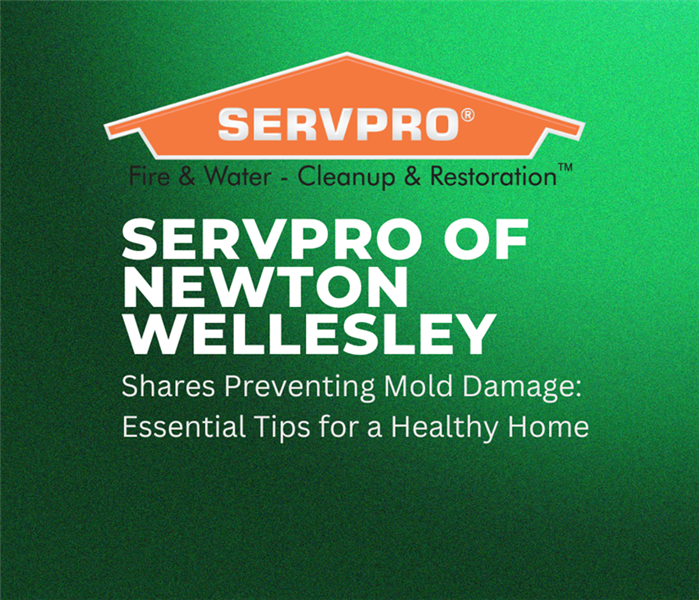 By following these tips, you can help prevent mold damage in your home, protecting your family's health and your home's structure.
By following these tips, you can help prevent mold damage in your home, protecting your family's health and your home's structure.
Mold damage can be a major problem in many homes, causing health problems and damaging the structure of the building. In order to prevent mold damage, it is important to understand the conditions that allow mold to thrive and what steps can be taken to prevent its growth.
Here are some tips to help you prevent mold damage in your home:
- Control humidity levels: Mold thrives in moist environments, so it is essential to keep indoor humidity levels low. Use a dehumidifier to remove excess moisture from the air
- Fix leaks: Promptly fix any leaks in your roof, walls, or plumbing to prevent water damage and mold growth
- Keep surfaces clean and dry: Regularly clean and dry surfaces in high-risk areas such as bathrooms, kitchens, and basements. Use a mold-resistant cleaning solution
- Increase ventilation: Ensure that your home has proper ventilation to help prevent mold growth. This can be achieved by opening windows and doors regularly, using exhaust fans, and keeping air vents clear.
- Inspect and maintain HVAC systems: Your heating, ventilation, and air conditioning systems can become a breeding ground for mold if not properly maintained.
- Store items properly: Store items, especially paper products and organic materials, properly in sealed containers to prevent mold growth.
- Regularly inspect your home: Regular inspections of your home can help identify mold damage early, allowing you to take action before it becomes a bigger problem.
- Look for discoloration on walls and ceilings, a musty odor, or any other signs of moisture damage.
By following these tips, you can help prevent mold damage in your home, protecting your family's health and your home's structure.
SERVPRO of Newton Wellesley is your premier choice for fire damage and restoration. Our teams are ready to respond 24 hours a week, any day of the year. When you bring us on the job our team of licensed contractors and certified technicians will work collaboratively with you throughout the duration of the project. They will keep you updated on the project's status and ensure that your expectations are met. We will help you to move forward and make it “Like it never even happened” for all of your fire damage.
SERVPRO Mold Remediation
12/2/2018 (Permalink)
When approaching mold clean up a lot of people wonder which method is best, “Dry Blast” vs “Sand Blast”, The answer is neither , the reality in today’s world is this is unnecessary because; dry ice is costly, it only removes surface mold, and porous materials require a deep cleaning. SERVPRO technicians use anti-fungal and anti-microbial treatments that kill mold colonies and help prevent new colonies from forming
When tackling mold we make it a priority to set up containment. All remediation companies will set up containment, but when and how is the issue. We set up containment prior to applying the “eyeball test”. Which is as follows
- The “Eyeball Test” – Assessing the Environment
- Has there been a previous water damage
- Do you smell musty odors of mold
- Do you see areas of mold contamination
- Our competitors cut 4 x 8 holes in the wall from the ground up
- We cut a 2 x 4 in the center of the wall
Our Four Legged Best Friends Can Also Help Detect Mold In Our Homes
10/4/2017 (Permalink)
Many professional home inspectors use specialized tools such as water pressure gauges, infrared thermometers, devices to detect moisture and some even use mold detecting dogs!
That’s right, dogs.
These highly trained dogs are qualified to detect at least 18 kinds of mold that are deemed harmful to humans. Their training is similar to bomb-sniffing dogs and drug-sniffing dogs.
When a home inspector cannot see behind the wall, their dogs are trained to sniff for mold in hidden places. They alert the inspector of where mold was detected by immediately sitting down in front of that area.
The home inspector can then do a more in-depth investigation in that area, pulling back the baseboard, cutting a small hole in the dry wall, or pulling out all of the contents of the bathroom or kitchen cabinets.
This additional investigation may also lead to spore sampling. This is a process where the inspector pulls a sample of the material, seals it in a vial, identifies it, and ships it off to an independent laboratory for analysis.
Luckily for our fury friends, the mold is not harmful to them as they have the special ability to purge odor and contaminments from their noses.
Another reason to love our best friend!






 24/7 Emergency Service
24/7 Emergency Service










